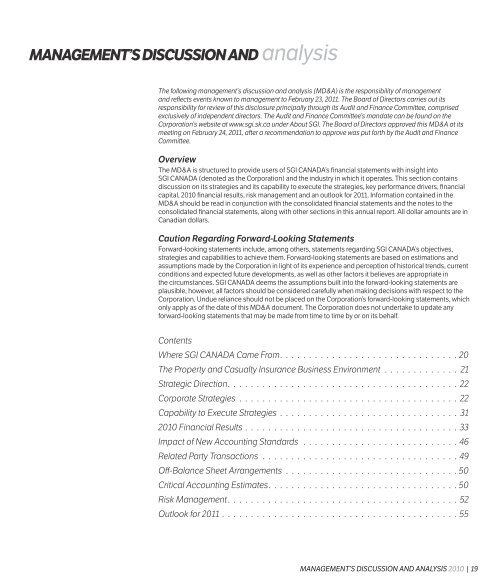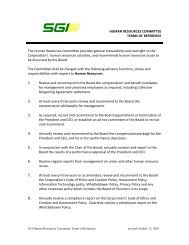Full report - SGI Canada
Full report - SGI Canada
Full report - SGI Canada
Create successful ePaper yourself
Turn your PDF publications into a flip-book with our unique Google optimized e-Paper software.
Due to the strength of the capital markets and the success of the investment manager in selecting stocks,<br />
investment write-downs were a minor consideration in 2010. Securities previously in significant unrealized<br />
loss positions recovered strongly resulting in only limited write-downs during the year, totaling $0.5 million<br />
for 2010 (2009 – $4.0 million).<br />
Of note for 2010 is the large increase in net realized gains on sale of investments, reversing the trend of<br />
the last few years. Realized gains are dependent on investment market conditions and trading activity of<br />
the investment manager. Improving economic fundamentals created a positive environment for equity<br />
markets, while continued low interest rates produced strong bond results. The Canadian equity market<br />
again led the strong performance driven by gains in commodity stocks.<br />
Performance relative to the benchmark portfolio varies from year-to-year, but over rolling four-year periods,<br />
investment performance remains satisfactory as illustrated in the following graph:<br />
Four-Year-Market based Returns to December 31<br />
Annual index returns ending December 31<br />
Asset Class Benchmark Index 2010 2009<br />
Canadian equities S&P/TSX Composite 17.6% 35.1%<br />
U.S. equities S&P 500 ($C) 9.1% 7.4%<br />
Non-North American equities MSCI EAFE ($C) 2.1% 11.9%<br />
Bonds DEX Universe Bond 6.7% 5.4%<br />
Short-term bonds DEX Short-term Bond 3.6% 4.5%<br />
Equity market gains in 2010 were widespread with the TSX Composite Index increasing 17.6%, the S&P<br />
500 rising 15.1% (9.1% in Canadian dollar terms) and non-North American equities, the EAFE Index, rising<br />
4.8% in aggregate local currency terms (2.1% in Canadian dollar terms). While foreign equities markets<br />
were strong during 2010, the corresponding increase in the Canadian dollar limited gains for Canadian<br />
investors.<br />
For purposes of portfolio management, a market-based rate of return is calculated that captures all interest<br />
and dividend income, as well as the impact of the change in market value of securities, both realized<br />
and unrealized. In 2010, the <strong>SGI</strong> CANADA portfolio’s market-based return was 7.6% compared to 9.9% in<br />
2009. In addition, the 2010 return was ahead of the benchmark portfolio return of 6.8% by 0.8% (2009<br />
outperformed the benchmark by 0.6%). Although the return in 2010 was lower than experienced in 2009,<br />
the strong performance was a result of large positive returns in each of Canadian and U.S. equities as well<br />
as fixed income. Value added over the benchmark in 2010 of 0.8% was due to strong relative fixed income<br />
and Canadian equity returns. Similar performance trends were seen in the portfolios for <strong>SGI</strong> CANADA<br />
Insurance Services Limited, Coachman Insurance Company and Insurance Company of<br />
Prince Edward Island.<br />
The primary investment performance objective of the portfolio is to earn a market-based return in excess<br />
of a benchmark portfolio return. The asset mix for the benchmark portfolio is set by the Board to be<br />
consistent with <strong>SGI</strong> CANADA’s risk profile and is reviewed on an annual basis. In addition, each subsidiary<br />
has its own investment portfolio with a policy consistent with its risk profile. The investment manager is<br />
permitted to vary the actual asset class weights around the benchmark portfolio, within the policy asset<br />
mix guidelines. The benchmark portfolio return is calculated by applying the benchmark portfolio weights<br />
to capital market index returns. While the portfolio’s rate of return is compared to the benchmark portfolio<br />
return on a quarterly basis, the performance measure is expected to be met over four years, a long enough<br />
period to capture a full market cycle. This longer-term measure is appropriate as it recognizes that the<br />
effectiveness of investment management styles varies depending on the market environment.<br />
Income taxes<br />
The Corporation’s out-of-province legal entities, <strong>SGI</strong> CANADA Insurance Services Ltd., Coachman and<br />
ICPEI are subject to corporate income tax, while <strong>SGI</strong> CANADA is not. On a consolidated basis,<br />
<strong>SGI</strong> CANADA recorded a tax expense of $2.5 million in 2010 compared to an expense of $1.0 million in<br />
2009. Excluding Saskatchewan operations, which are non-taxable, this results in a tax rate of 31.8%,<br />
compared to the expected tax rate of 30.2%. The primary reasons for the difference is that changes in the<br />
statutory tax rates have decreased the value of the future tax asset resulting in a corresponding increase<br />
to income tax expense, and there was additional tax related to the sale of equity accounted investments.<br />
However, these are partially offset by investment income, specifically Canadian dividend revenue, which is<br />
not subject to tax.<br />
38 | 2010 MANAGEMENT’S DISCUSSION AND ANALYSIS MANAGEMENT’S DISCUSSION AND ANALYSIS 2010 | 39















